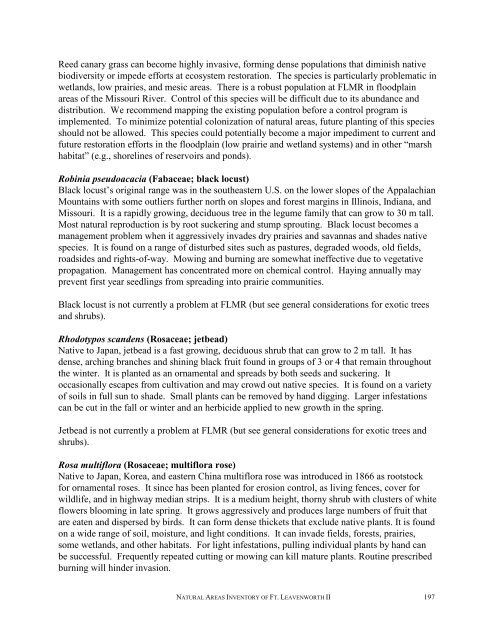A Natural Areas Inventory of the - Kansas Natural Heritage Inventory ...
A Natural Areas Inventory of the - Kansas Natural Heritage Inventory ...
A Natural Areas Inventory of the - Kansas Natural Heritage Inventory ...
Create successful ePaper yourself
Turn your PDF publications into a flip-book with our unique Google optimized e-Paper software.
Reed canary grass can become highly invasive, forming dense populations that diminish native<br />
biodiversity or impede efforts at ecosystem restoration. The species is particularly problematic in<br />
wetlands, low prairies, and mesic areas. There is a robust population at FLMR in floodplain<br />
areas <strong>of</strong> <strong>the</strong> Missouri River. Control <strong>of</strong> this species will be difficult due to its abundance and<br />
distribution. We recommend mapping <strong>the</strong> existing population before a control program is<br />
implemented. To minimize potential colonization <strong>of</strong> natural areas, future planting <strong>of</strong> this species<br />
should not be allowed. This species could potentially become a major impediment to current and<br />
future restoration efforts in <strong>the</strong> floodplain (low prairie and wetland systems) and in o<strong>the</strong>r “marsh<br />
habitat” (e.g., shorelines <strong>of</strong> reservoirs and ponds).<br />
Robinia pseudoacacia (Fabaceae; black locust)<br />
Black locust’s original range was in <strong>the</strong> sou<strong>the</strong>astern U.S. on <strong>the</strong> lower slopes <strong>of</strong> <strong>the</strong> Appalachian<br />
Mountains with some outliers fur<strong>the</strong>r north on slopes and forest margins in Illinois, Indiana, and<br />
Missouri. It is a rapidly growing, deciduous tree in <strong>the</strong> legume family that can grow to 30 m tall.<br />
Most natural reproduction is by root suckering and stump sprouting. Black locust becomes a<br />
management problem when it aggressively invades dry prairies and savannas and shades native<br />
species. It is found on a range <strong>of</strong> disturbed sites such as pastures, degraded woods, old fields,<br />
roadsides and rights-<strong>of</strong>-way. Mowing and burning are somewhat ineffective due to vegetative<br />
propagation. Management has concentrated more on chemical control. Haying annually may<br />
prevent first year seedlings from spreading into prairie communities.<br />
Black locust is not currently a problem at FLMR (but see general considerations for exotic trees<br />
and shrubs).<br />
Rhodotypos scandens (Rosaceae; jetbead)<br />
Native to Japan, jetbead is a fast growing, deciduous shrub that can grow to 2 m tall. It has<br />
dense, arching branches and shining black fruit found in groups <strong>of</strong> 3 or 4 that remain throughout<br />
<strong>the</strong> winter. It is planted as an ornamental and spreads by both seeds and suckering. It<br />
occasionally escapes from cultivation and may crowd out native species. It is found on a variety<br />
<strong>of</strong> soils in full sun to shade. Small plants can be removed by hand digging. Larger infestations<br />
can be cut in <strong>the</strong> fall or winter and an herbicide applied to new growth in <strong>the</strong> spring.<br />
Jetbead is not currently a problem at FLMR (but see general considerations for exotic trees and<br />
shrubs).<br />
Rosa multiflora (Rosaceae; multiflora rose)<br />
Native to Japan, Korea, and eastern China multiflora rose was introduced in 1866 as rootstock<br />
for ornamental roses. It since has been planted for erosion control, as living fences, cover for<br />
wildlife, and in highway median strips. It is a medium height, thorny shrub with clusters <strong>of</strong> white<br />
flowers blooming in late spring. It grows aggressively and produces large numbers <strong>of</strong> fruit that<br />
are eaten and dispersed by birds. It can form dense thickets that exclude native plants. It is found<br />
on a wide range <strong>of</strong> soil, moisture, and light conditions. It can invade fields, forests, prairies,<br />
some wetlands, and o<strong>the</strong>r habitats. For light infestations, pulling individual plants by hand can<br />
be successful. Frequently repeated cutting or mowing can kill mature plants. Routine prescribed<br />
burning will hinder invasion.<br />
NATURAL AREAS INVENTORY OF FT. LEAVENWORTH II 197


